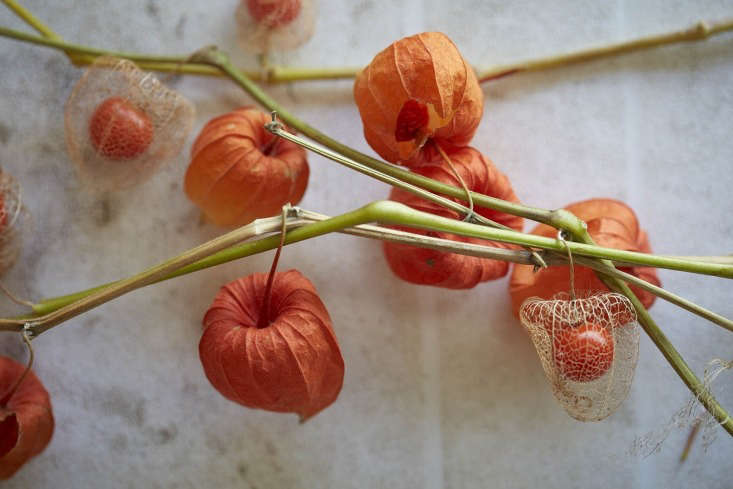With the Lunar New Year coming up on February 10, we’re resurfacing this story from our archives about using Chinese lanterns in floral arrangements. Consider yourself lucky if you come across the stems at your local flower shop—and bring them home to artfully decorate for the holiday.
Chinese lanterns have a mystique that may be lost on the innocent gardener. A couple of seasons after being planted and even forgotten, the large leaves and unremarkable white flowers of this ornamental plant emerge everywhere, even in a lawn. Yet, as fountains of papery calyces turn from green to a deep autumnal orange, the point of persevering with this aggressive spreader becomes clear.
Artist Fiona Haser Bizony, formerly of Electric Daisy Flower Farm in Bradford-on-Avon, harvested hers in September, then hung them indoors to dry for a couple of months, having first stripped the leaves. What do they go with? Everything.
Photography by Britt Willoughby Dyer, for Gardenista.

The notoriety of Physalis alkekengi is somehow compounded by the knowledge that it is a member of the nightshade family, which includes tomato, potato, and highly poisonous belladonna. Clearly, the solution for taming this orange “bladder” (from which its name derives in ancient Greek) is to grow it specifically for harvesting, all by itself. In a wilder garden, Chinese lanterns light up a hedge, when grown in rough grass around the perimeter. Sun preferred.

In preparing her lantern harvest for an arrangement, Fiona simply took a look around. “This is the result of a lovely bit of foraging in the hedgerows around our new farm for autumnal foliage and berries,” she says. Being a highly innovative flower decorator (she’s Florist in Residence for the Royal Horticultural Society, among other honors), Fiona is not short of homegrown flowers to complement Chinese lanterns.

Lanterns do not need to be dried; earlier in the season they complement blue salvias, glaucous gray-green eucalyptus, and magenta dahlias.


The hoop shown here is a useful metal frame for floral decoration, standing at a height of 3 feet. “It is decorated according to the season,” says Fiona. “It can be a centerpiece for a wedding or an elaborate entertainment.”

Other members of the Physalis family include Cape gooseberry and tomatillo, which becomes clear when the cases go from being papery to becoming completely desiccated, the little (edible) fruit gleaming inside. The paler lanterns shown here have been drained of color through exposure to sun.

Follow Fiona on Instagram to see what she’s up to these days since selling her farm.
N.B.: This post has been updated with new links and information; it was first published November 2017.
See also:
- Trend Alert: Winter Wreaths Gone Wild
- Gardening 101: Chinese Fringe Flower
- 10 Chinese Herbs to Cure What Ails You









Have a Question or Comment About This Post?
Join the conversation